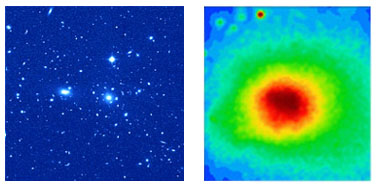Black Holes & Quasars
How can an X-ray telescope provide new information about the warping of space around black holes?Some of the most intense X-ray sources in the universe are caused by super-hot gas that is swirling toward a black hole. As the tremendous gravity of a black hole pulls gas and dust particles toward it, the particles speed up and form a rapidly rotating flattened disk. Friction caused by collisions between the particles heats them to extreme temperatures. Just before they pass beyond the event horizon of the black hole, the particles produce X-rays as their temperatures rise to many millions of degrees. By precisely determining the energy of individual X-rays, Chandra X-ray Observatory can measure the motion of particles near black holes. This information will allow scientists to test theories about the gravity fields around black holes.
Can X-ray observations of quasars detect the spectral signatures of supermassive black holes?
Astrophysicists have proposed that supermassive black holes may explain the mysterious and powerful objects called quasars. These objects radiate as much energy per second as a thousand normal galaxies from a region having a diameter less than a millionth of the size of one galaxy. Because the matter closest to the event horizon of a black hole radiates most of its energy as X-rays and gamma rays, Chandra X-ray Observatory will present an unequaled view into the inner workings of these violent cosmic whirlpools.

Artist's rendition of the violent whirlpool of hot gas and high-energy jets near a supermassive black hole. (SAO)
Clusters of Galaxies & Dark Matter
If much of the matter in the universe is so hot that it can be observed only with an X-ray telescope, where can large quantities of multimillion degree gas be found?
The UK Schmidt optical image (left) of the Coma cluster shows light from thousands of galaxies, whereas the Rosat X-ray image (right) reveals a massive cloud of 80 million degree gas.
More than half of all galaxies in the universe are members of groups of galaxies or larger collections of galaxies, called clusters. X-ray observations have shown that most clusters of galaxies are filled with vast clouds of multimillion degree gas. The mass of this gas is greater than all the stars in all the galaxies in a cluster of a thousand galaxies.
Can Chandra shed some light on the dark matter mystery?
The X-ray producing hot gas found in a typical cluster of galaxies also presents astronomers with a grand puzzle. Over time this extremely hot gas should escape the cluster since the galaxies and gas do not provide enough gravity to hold it in. Yet in clusters of all ages the gas remains. Scientists have concluded that some unobserved form of matter, called dark matter, is providing the extra gravity needed to hold the hot gas in the cluster. An enormous amount of dark matter is needed— about three to ten times as much matter as that observed in the gas and galaxies.
This means that most of the matter in the universe may be dark matter! The dark matter could be collapsed stars, planets or black holes. Or strange subatomic particles that produce no light, and can only be detected through their gravity. Detailed measurements of the size and temperature of the hot gas clouds in galaxy clusters by Chandra X-ray Observatory could help solve the dark matter mystery.
